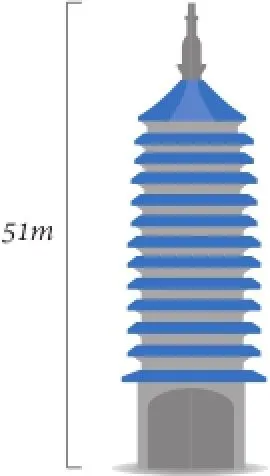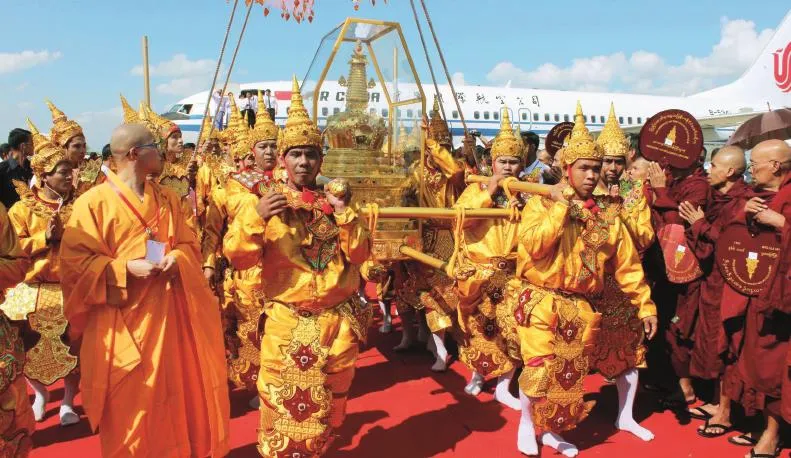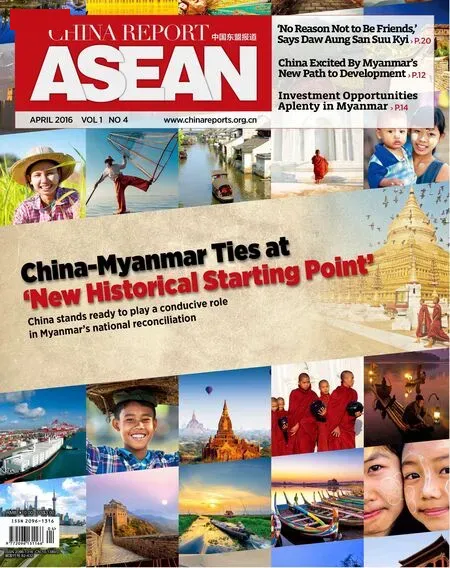Buddhist Exchanges Key to Mutual Understanding
2016-09-26ByTanXingyu
By Tan Xingyu
Buddhist Exchanges Key to Mutual Understanding
By Tan Xingyu
On June 11, 2015, Daw Aung San Suu Kyi, General Secretary of Myanmar's National League for Democracy (NLD), and her staff visited the Lingguang Temple on the outskirts of Beijing to worship the Buddha Tooth Relic. Dressed in traditional Myanmar blue and white sarongs, Daw Aung San Suu Kyi and her staf paused for a moment in front of the Buddha Tooth Relic shrine to appreciate the stunning architecture. Ten, they went up the stairs to worship before the statue of Buddha on the frst foor, before finally walking around the shrine to reach the north gate, entering to worship the Buddha Tooth Relic itself. The temple visit was one of Daw Aung San Suu Kyi's few engagements during her visit to the Chinese capital.
The Lingguang Temple is massively important in Buddhism and is sure to be a top priority among Buddhist visitors to Beijing, regardless of whether the visitor is a head of state or an ordinary tourist. As most Myanmar people are Buddhists, the Tooth Relic itself is a sacred object to the citizens of Myanmar.
When a Chinese Buddhist delegation visited Myanmar in April 1955, the Myanmar side proposed the Buddha Tooth Relic be sent to Myanmar so it could be worshiped by the people there. On October 3 that year, Premier Zhou Enlai hosted a banquet for a delegation from Myanmar in Beijing. He told them: “You have come to China to welcome the Buddha Tooth Relic back to Myanmar to be worshiped by your compatriots. The Chinese Government and people are very willing to help you complete this mission.”On October 15, the relic arrived in Yangon, attracting over 1 million pilgrims from many parts of the country. Such worship tours were also held in 1994 and 1996 respectively, all receiving a warm welcome.
The latest tour, lasting 48 days in 2011, attracted 4 million pilgrims. The Myanmar government also presented part of pilgrims' donations to the Chinese Buddhist circle, which pledged that the donations would be mainly used for Buddhism and philanthropy in Myanmar. A total of four tours of China's Buddha Tooth Relic to the same country, Myanmar, was unprecedented, demonstrating the friendly and close relationship between the Chinese and Myanmar Buddhist communities.
China and Myanmar are close neighbors, with friendly exchanges extending over 2,000 years that have forged a profound friendship. Buddhism has all along constituted a strong bond. Legend has it that two famous Indian monks - Kasyapa Matanga and Dharmaratna - came to China by way of the upper reaches of the Irrawaddy River in the first century AD. According to historical records, they were the frst Buddhist monks to reach China. Subsequently, there was a constant stream of Indian dignitaries coming to China via Myanmar territory, and their Chinese counterparts used the same route to go to India to bring back Buddhist scriptures. Thus, Myanmar served as a transit hub for exchanges between Chinese and Indian civilizations.
Bordering Myanmar, southwest China's Yunnan Province has intensive exchanges with the Buddhism practiced by its neighbor. It is generally believed that the Theravada Buddhism prevailing in ethnic Dai areas in Yunnan was first introduced around the 6th century by travelers from Myanmar. Until the end of the 16th century, Teravada Buddhism still had a fairly large influence in Xishuangbanna, an ethnic Dai area in the south of Yunnan Province. Later on, however, Buddhism in Xishuangbanna was more strongly influenced by Thai Buddhism, due to geographical factors. Yunnan's Dehong, further west, remains a hub of Buddhist cultural exchange between China and Myanmar.
Besides exchanges on Buddhist scriptures and philosophy, the culture and art related to the Buddhism of the two countries such as astronomy, calendars, architecture, sculptures, music and dance were also blended, developed and promoted across their joint border.
Beijing's Lingguang Temple (Temple of Divine Light)

Located just outside the Chinese capital's ffth ring road, the Lingguang Temple (Temple of Divine Light) is one of the eight Buddhist temples and monasteries scattered across the Cuiwei, Pingpo and Lushi hills on the western side of Beijing. The temple is home to one of only two ofcially recognized
Buddhist Tooth Relics in the world (the other is in Sri Lanka). The site is a popular destination for Buddhist travelers to Beijing and was built between 766-779 A.D. during the Tang Dynasty. The overall structure is 51 meters high at its tallest point, and its marble base stands nearly three meters of the ground.
World Famous Pagodas
Due to its role as a key political, economic and cultural center in ancient times, Myanmar's Pagan still has over 2,000 world-famous pagodas. These include not only those adopting the artistic forms and styles unique to various ethnic groups of Myanmar but also Chinese-style pagodasand Buddha statues introduced from China. The Anande Temple in Pagan contains buildings with multi-layer eaves similar to those of Chinese temples and preserves 1,500 murals, some having many similarities with the Dunhuang murals in Western China.

Under the escort of prominent monks, the Buddha Tooth Relic arrives in Myanmar for 48 days of worship and pilgrimage in Nov 2011. The Tooth Relic is usually housed in Beijing's Lingguang Temple.
With the continuous development of bilateral relations between China and Myanmar, Buddhist exchanges have become increasingly frequent. On June 28, 2014, Myanmar President U Tein Sein visited the Lingguang Temple in Beijing and attended the consecration ceremony for a jade Buddh a presented by the Myanmar Government. The jade produced in Myanmar is considered ideal for Buddha statue carving. Since ancient times, Chinese temples have felt honored to enshrine a jade Buddha from Myanmar. Tey vary in gesture and posture - lying, standing or sitting. Their exquisite craftsmanship is much admired, not only strengthening Buddhist exchanges between the two countries but also promoting the development of China's carving art.
Two days after visiting the Lingguang Temple, President U Thein Sein visited the Baima Temple in Luoyang, Henan Province, where he attended the inauguration and consecration ceremony of a Myanmar-style Buddhist hall, donated by the Myanmar Government and people. In the midst of a grand, solemn and peaceful atmosphere, Chinese and Myanmar monks jointly chanted sutras and prayers for the hall. After the ceremony, President U Thein Sein formally handed over a full set of materials concerning the hall to the abbot of the Baima Temple.
Buddhist Cultural Exchanges
As Myanmar's Theravada Buddhism garners a great deal of international respect, the Buddhist Association of China sent several monks to Myanmar in 1996 for Buddhist studies, opening a new chapter in China-Myanmar Buddhist cultural exchanges.
The monks received a five-year traditional education in the National Buddhist University of Myanmar, covering commandments, Abhidhamma (Higher Teachings of the Buddha), Buddhism history, Pali (Buddhist scripture), Myanmar language and other courses. They all received advanced diplomas issued by the Government of Myanmar in Mandalay in December 2000, therefore becoming the first batch of Chinese monk students in Myanmar since the establishment of diplomatic relations. They have had a profound impact in Chinese-Myanmar Buddhist circles.
In recent years, Myanmar has grown to become a popular place of travel among Chinese tourists. Gradually, China's urban white-collar workers begin to have a keen interest in travel for Buddhist meditation.
But the travel has gone both ways. Monks from Baofeng Temple in Jiangxi Province have repeatedly invited eminent monks of Myanmar such as U Jatila Sayadaw and U Pandita Sayadaw to visit Jiangxi and teach the techniques of Vipassana (meaning“to see things as they really are”) meditation.
Buddhist exchanges form an important part of cultural exchange between China and Myanmar. The two peoples have learned from one another through communication, and are currently in the midst of a brilliant chapter of exchange between civilizations.
杂志排行
China Report Asean的其它文章
- My 10 Months in Peaceful Yangon
- Yangon's Golden Pagoda A Magnifcent Tribute to Buddha
- Drama Depicts Ancient China-Myanmar Friendship
- Hydropower Projects Illuminate Both Sides of the Irrawaddy River
- Power Station Construction a Boon for Myanmar People
- Students on the Forefront of Friendship-Boosting Cultural Exchanges
